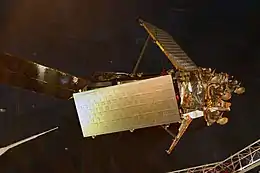Iridium 77
Iridium 77 was a communications Satellite which was part of a satellite constellation known as Iridium, named after the 77th chemical element of the periodic table, iridium. It was owned and funded by Iridium, a communications company.
 Iridium satellite, constructed entirely from spares and donated by Motorola to the National Air and Space Museum. | |
| Mission type | Communications |
|---|---|
| Operator | Iridium |
| COSPAR ID | 1998-051E |
| SATCAT no. | 25471 |
| Mission duration | 19 years |
| Spacecraft properties | |
| Spacecraft type | Iridium |
| Manufacturer | Motorola |
| Start of mission | |
| Launch date | September 8, 1998, 21:13:00 UTC |
| Rocket | Delta II 7920-10C |
| Launch site | Vandenberg SLC-2W |
| Contractor | Iridium |
| Orbital parameters | |
| Reference system | Geocentric |
| Regime | Polar Orbit |
| Eccentricity | 0.00145 |
| Periapsis altitude | 520 km |
| Apoapsis altitude | 540 km |
| Inclination | 86° |
| Period | 95 minutes |
| Epoch | 1998-09-08 |
Network
Iridium 77 is a part of a space-based communications system called Iridium. Conceived, designed, and built by Motorola, the Iridium system provides wireless, mobile communications through a network of 66 satellites in polar, low-Earth orbits. Inaugurated in November 1998, under the auspices of Iridium LLC, this complex space system allowed callers using hand-held mobile phones and pagers to communicate anywhere in the world—a first in the history of telephony.
Overview
Launch
It was launched by Delta II 7920 from Vandenberg Air Force Base on 8 September 1998 at 21:13:00 UTC[1] along with four other satellites, all of which were Iridium satellites.
Features
Iridium 77 is 3-axis stabilized, with a hydrazine propulsion system. It has 2 solar panels with 1-axis articulation. The system employs L-Band using FDMA/TDMA to provide voice at 4.8 kbit/s and data at 2.4 kbit/s with 16 dB margin. The satellite has 48 spot beams for Earth coverage and uses Ka-Band for crosslinks and ground commanding.[2]
References
- "Iridium 77". nssdc.gsfc.nasa.gov. NASA. August 16, 2013. Retrieved March 30, 2014.
- "Iridium 77". nssdc.gsfc.nasa.gov. NASA. August 16, 2013. Retrieved March 30, 2014.